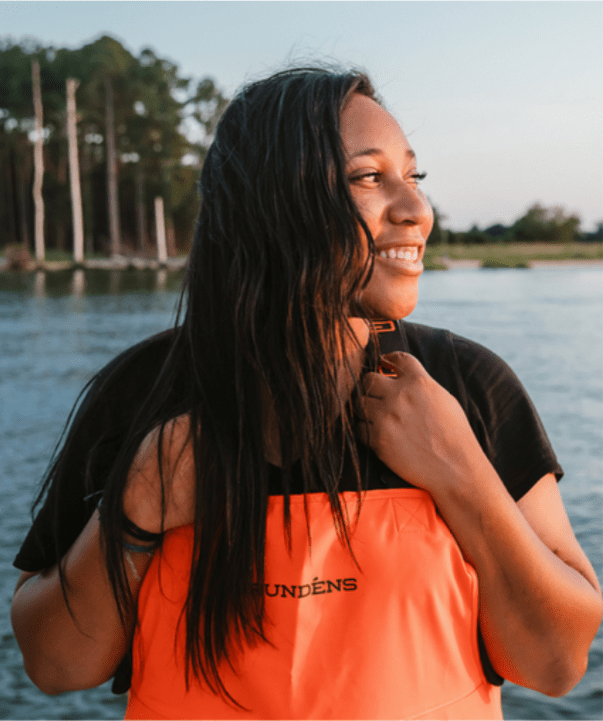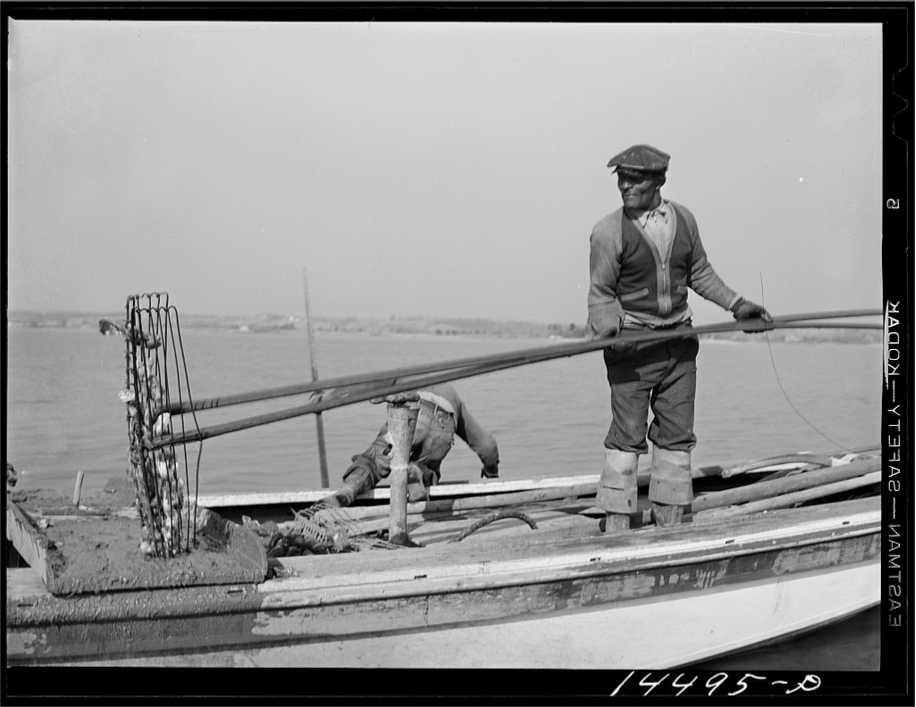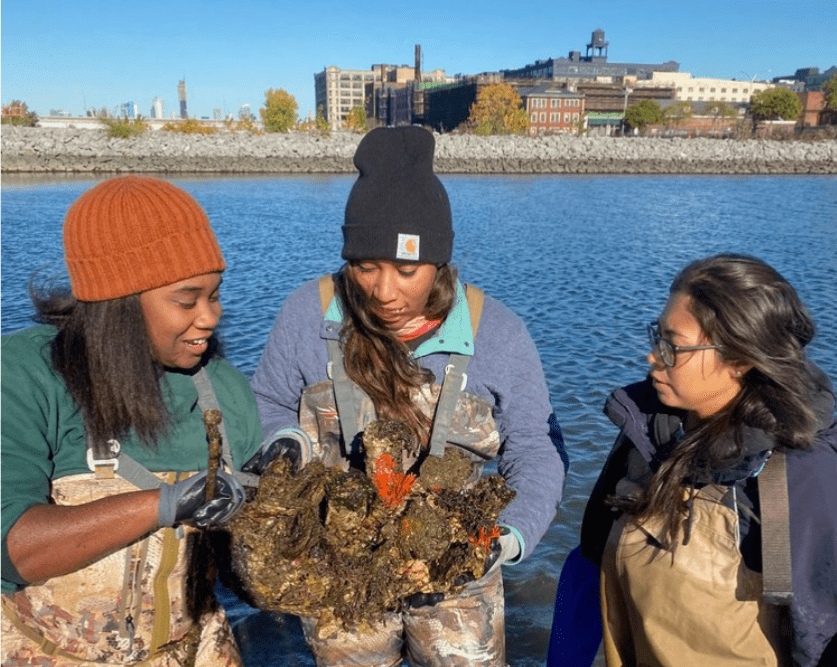
Imani Black // Credit: Minorities in Aquaculture
Imani Black is reshaping and rethinking the aquaculture industry. From founding Minorities in Aquaculture (MIA) to her own personal research on shellfish aquaculture and Black maritime history, Imani is making an impact. In just three short years, MIA has partnered with the NOAA Sea Grant program, the Pew Research Center, the Chesapeake Bay Program, Virginia Institute of Marine Sciences, and other organizations to connect women of color in the aquaculture industry on a local and global scale.
Imani’s passion for the Chesapeake Bay did not develop overnight. She can trace her family’s watermen roots in Maryland back over 200 years. In high school, her interest in marine sciences led her focus to the eastern oyster. The oyster has connected many aspects of life in the bay, from cultural to economic to ecological, for hundreds of years. This led Imani to study Marine Biology in college and pursue a career in aquaculture. Like many other African American families, Imani’s and her family have been engaged in the stewardship of the Chesapeake for generations.
The legacy of Black maritime history in the Chesapeake Bay is frequently, and often intentionally, overlooked. African Americans have been crabbing, fishing, sailing, and managing the waters since the arrival of colonists to what would be called Jamestown, Virginia in 1619. Building boats, forging metal oyster tongs, Black people have made long lasting and widespread impacts on the waters and cultures of the Chesapeake Bay. Some of the first African Americans to legally be considered citizens of the United States were “Black Jacks”, watermen and oyster fishers from the Chesapeake Bay Region. These Black Jacks possessed a Seamen’s Protection Certificate, granting them American citizenship around 70 years before the Emancipation Proclamation. From harvesting to packing, African Americans across the Chesapeake Bay mastered highly specialized skills that frequently made them more adept sailors than most white sailors. Along with harvesting oysters for sale in markets, African American watermen planted shellfish for later sale at the market, creating some of the first “aquaculture” seen in the region.
However, commercial aquaculture as it is known today wasn’t introduced into the Chesapeake Bay until the 1990’s. Aquaculture is the cultivation of aquatic organisms through breeding, raising, and harvesting in controlled environments. Following the major population declines of oysters from diseases, overfishing, and environmental changes in the bay in the late 20th century, aquaculture was introduced as a way to support the demands of the oyster industry without destroying wild fisheries. Through shellfish leases, watermen have the ability to farm shellfish, most commonly oysters, in sections of a body of water. In the 1970’s, nearly a third of leaseholders on the Nanticoke River in Virginia were Black men. Today, aquaculture is the fastest growing food industry globally. However, aquaculture accounted for only 7% of the United States’ total domestic production of seafood in 2022. In the Chesapeake Bay, the industry is overwhelmingly white and overwhelmingly male.

Oyster tonger. Wicomico River, Maryland, 1941. // Credit: Reginald Hotchkiss, Library of Congress
Together with wild-caught harvest, aquaculture attempts to create a more sustainable way to utilize fisheries. Seafood is central to the economy and culture of the Chesapeake Bay region, but without change there could be no population left to fish. The growth of the aquaculture industry is key to maintaining healthy wild fisheries, especially in the Chesapeake Bay. “Sustainability for me is when both areas, environmentally and economically, are balanced,” says Imani. “Then, that’s when we really have sustainable industry. Aquaculture falls into that because the ultimate goal is to play to both, feed into both.”
This sustainability, in practice, prioritizes economics and ecology while omitting the importance of people. Cultural sustainability, or keeping the traditions and heritage alive of populations, has fallen by the wayside. In Maryland, Imani can only name one aquaculture farm that is owned by an African American. She can name none owned by women. Of the 11,244 licensed captains employed in the United States, only 6.7% are Black or African-American. African Americans have championed traditions of stewardship and connection between the people and the water, but this isn’t reflected in the region’s current demographic of aquaculturists.
Imani wanted to make a change. In 2020, she founded Minorities in Aquaculture (MIA). “I didn’t start MIA to be this big thing,” says Imani. “I just impulsively was like ‘I have never worked with another woman of color in my space’ and I wanted to expand on that.” The mission of MIA is to educate minority women about the benefits provided by local and global aquaculture in order to promote a more diverse, inclusive aquaculture industry.
Like the discovery that Imani had herself, MIA wishes to bring more women of color in the industry. “We are trying to build a successful pipeline and bridge between aquaculture and the groups that are unrepresented in the industry using [Diversity, Equity, and Inclusion] DEI tactics.” As of MIA’s 2023 annual report, the organization has supported over 200 members globally, raised over $200,000 in support for program funding, as well as fully funding internship positions in the aquaculture industry for 17 women of color since 2023. When only 15% of nearly 60 million full-time workers in the aquaculture industry globally are women, these internship positions allow for more stability and support when entering the workforce.
Now a masters student at the University of Maryland’s Horn Point Laboratory, Imani is adding academia to her list of oyster experience. In her studies, she personal experience of the aquaculture industry to the discussion while highlighting the voices of minorities. The miscommunications between what is realistically beneficial to aquaculturists, whether intentional or not, create more issues for the industry as a whole. Imani says, “What’s important here isn’t necessarily important in another sector, it isn’t viewed in the same way. For all of us to get on the same page we have to understand each other’s value systems.” To better understand these value systems, MIA conducted a 2023 survey of the experiences regarding women, women of color, and the LGBTQIA+ community in aquaculture. Of the over 140 respondents, 77% report struggling to remain in the industry long-term because of a lack of financing or grants. This census aims to unite interests of minorities in aquaculture in setting a baseline for understanding what it means to be a minority in aquaculture and inform future advocacy.
As Imani continues her work with MIA, her graduate research informs the organization’s mission. “It’s been an experience of understanding the different nuances of academia and how they are different from the sectors I have been in aquaculture. But also, I have been really intentional about the research I’ve been doing,” says Imani. Through her research collecting oral histories, Imani is compiling the first account of Black maritime history in the Chesapeake Bay since the 1990’s written by a member of the community. “I didn’t want to just do a lab project that was on my advisor’s list of projects that he wanted to do. My research is the only social science based project at Horn Point right now. It’s really looking at the historic involvement of African Amerians in the Chesapeake Bay commercial fisheries, trying to figure out the domino effect of how we went from being one of the most predominant demographics in fisheries for a very long time to now having only 12 living Black commercial captains still working.”

MIA founder Imani Black talks oysters with the women of the Billion Oyster Project in NYC. // Credit: Courtesy of Caroline J. Phillips and Jeannette Ralyea Watson, Minorities in Aquaculture.
Imani Black and Minorities in Aquaculture strive to connect people to science and industry, educating and promoting diversity and excellence while simultaneously changing the landscape of aquaculture as a whole. Further information about Minorities in Aquaculture and Imani’s research can be found at www.mianpo.org and on Instagram at @imaniiiblackkk.